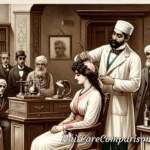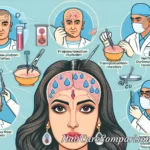Aging is an inevitable process that affects every aspect of our lives, including the quality and appearance of our hair. For those who have undergone hair transplant surgery, understanding how aging impacts the results is crucial. This article delves into the effects of aging on hair transplants, offering insights into what one can expect as the years roll on.
The Basics of Hair Transplantation
Hair transplantation is a surgical technique that removes hair follicles from one part of the body, known as the ‘donor site,’ to a bald or balding part of the body known as the ‘recipient site.’ It is primarily used to treat male pattern baldness. With advancements in technology, the outcomes of hair transplants have significantly improved, but the question remains: how does aging affect these results?
Understanding the Aging Process
Aging affects our hair in various ways, from thinning to greying, and even pattern baldness. It’s important to understand that hair transplants do not halt the aging process. The transplanted hair, just like the rest of your hair, will undergo the natural changes that come with aging.
The Longevity of Hair Transplants
Genetic Factors and Hair Loss
While transplanted hair is generally resistant to the DHT hormone responsible for male pattern baldness, it’s not immune to other genetic factors that can affect its longevity. Understanding the science behind hair transplant grafts is key to setting realistic expectations about the aging of transplanted hair.
Environmental and Lifestyle Factors
Aside from genetics, environmental and lifestyle factors such as stress, diet, and exposure to pollutants can also impact the aging of transplanted hair. Protecting your hair from these factors is crucial in maintaining its health and appearance over time.
Changes in Hair Texture and Color
Graying of Transplanted Hair
Just like the rest of your hair, transplanted hair will eventually gray as you age. This is a natural process that reflects changes in melanin production over time.
Texture Changes Over Time
Transplanted hair can also undergo changes in texture due to aging. It may become finer or coarser, depending on individual genetic factors and how well the hair is cared for post-transplant.
Possible Need for Additional Procedures
Continuing Hair Loss
As aging continues, you may experience further hair loss around the transplanted areas. This could necessitate additional hair transplant sessions to maintain the desired aesthetic outcome.
Adjustments for Natural-Looking Results
Over time, adjustments may be needed to ensure that the transplanted hair blends seamlessly with your natural hair, maintaining a consistent and natural look as you age.
Maintaining Hair Health Post-Transplant

After a hair transplant, it’s crucial to take steps to maintain the health of your transplanted hair. This includes following a healthy diet, using gentle hair care products, and avoiding harsh treatments that can damage hair.
Post-Transplant Care and Aging
Proper care of your transplanted hair can significantly impact how it ages. Regular check-ups with your hair transplant surgeon, along with personalized hair care routines, can help mitigate the effects of aging on your transplanted hair.
Potential Side Effects of Aging on Hair Transplants
While hair transplants are generally safe, it’s important to be aware of potential side effects that can be exacerbated by aging, such as thinning or changes in hair texture. Understanding these potential issues can help you manage your expectations and care for your transplanted hair more effectively.
The Role of Innovation in Hair Transplant Techniques
As the field of hair transplantation evolves, new techniques and technologies are being developed that may minimize the aging effects on transplanted hair. Staying informed about these innovations can offer additional options for managing the appearance of aging hair.
Conclusion
While aging inevitably affects hair transplants, understanding the factors at play and how to effectively manage them can help ensure that your transplanted hair remains healthy and vibrant for as long as possible. By considering the genetic, environmental, and lifestyle factors, along with proper care and potential for future procedures, individuals can maintain a natural and youthful appearance well into the future. For more insights into managing the effects of a hair transplant over time, exploring the consequences of early hair transplants and skin effects of hair transplants can provide valuable information for anyone considering or having undergone this procedure.






